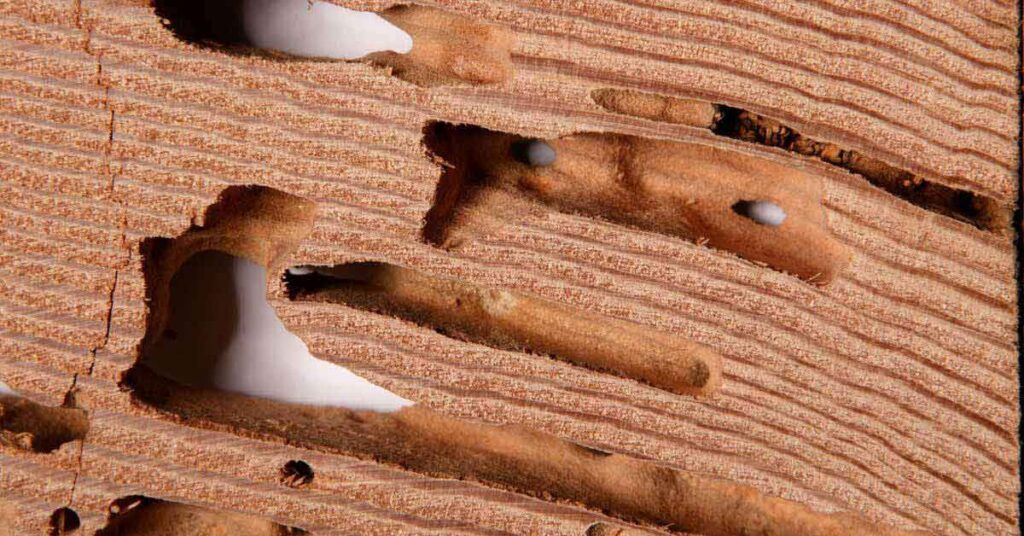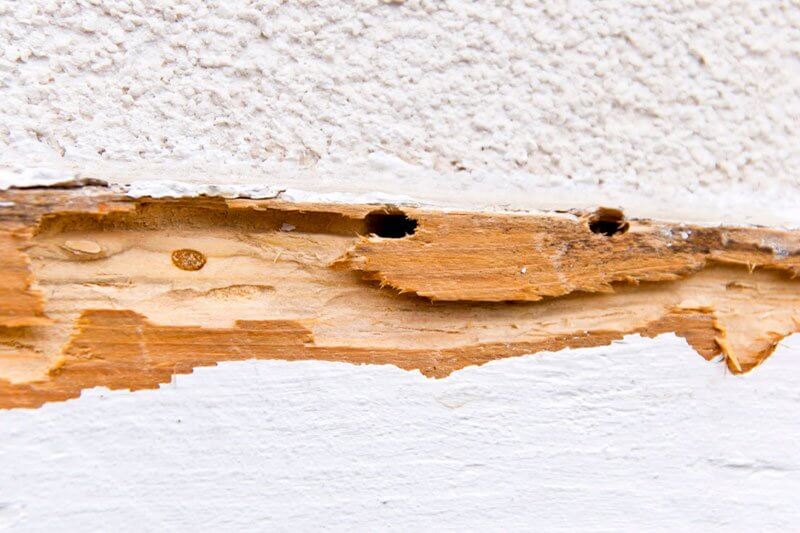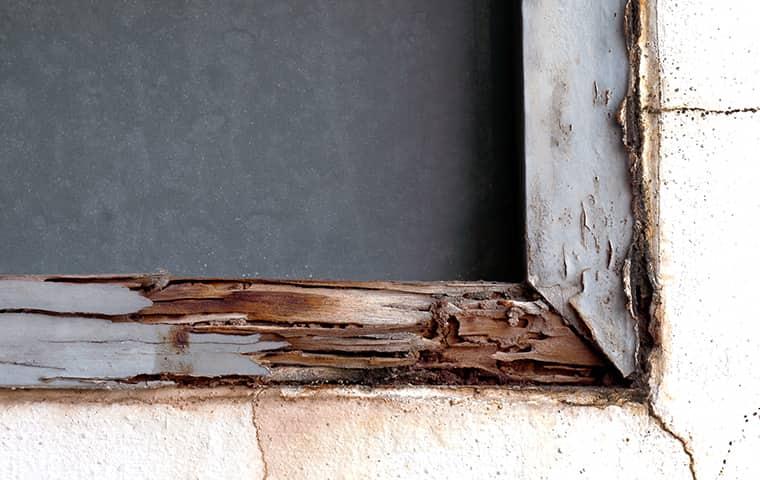Here are some signs that clearly indicate that you have termites in your walls.
- Look for small, discarded wings near windows and doors.
- Check for tiny holes in the wood with powdery residue beneath.
- Tap on the walls and listen for hollow sounds or rustling noises.
- Examine paint or wallpaper for bubbling or buckling.
- Search for mud tubes along walls connecting to the ground.
- Listen for faint rustling or clicking sounds when near the walls.
- Shine a flashlight along the wood’s surface for tunnels or damage.
Signs of Termite Infestation in Walls

Termites are stealthy pests that can silently wreak havoc on your home, particularly in the walls, where they often go unnoticed.
In this section, I’ll explore the telltale signs of termite infestations in your walls, both visible and non-visual indicators, to help you detect and address these destructive insects.
A. Visible Indicators:
Hollow-Sounding or Damaged Wood:
- Gently tap on the walls with your knuckles or a small tool.
- If you hear a hollow, papery sound, it may suggest termite damage.
- Termites consume wood from the inside, leaving the outer layers intact but weakened.
Mud Tubes or Tunnels:
- Inspect the exterior and interior of your walls.
- Look for small, pencil-sized mud tubes or tunnels running along the surface.
- Termites build these tubes to protect themselves as they move between their nest and their food source – your walls.
Discarded Wings:
- Examine window sills, door frames, or any well-lit areas around your home.
- Termites shed their wings after swarming and establishing a new colony.
- Finding these discarded wings is a strong indicator of termite activity.
B. Non-Visual Indicators:
Soft, Sagging, or Discolored Walls:
- Gently press on different sections of your walls.
- If the wall feels soft, sags, or shows unexplained discoloration, it could signify termite damage.
- Termites can weaken the wood structure, causing these issues.
Presence of Termite Droppings or Frass:
- Inspect any small holes or crevices in the walls.
- Look for tiny, pellet-like droppings or frass.
- Termites expel these droppings as they tunnel through the wood, often accumulating beneath the holes.
Peculiar Musty Odor:
- Pay attention to any strange, musty odors in your home.
- Termites can release chemicals that create a distinctive, unpleasant smell.
- A peculiar odor near your walls can indirectly indicate termite presence.
In conclusion, early detection of termite infestations in your walls is crucial to prevent extensive damage.
If you observe any of these signs, it’s essential to consult a pest control professional immediately. They can inspect your home thoroughly and suggest the right steps to protect
Conducting a DIY Termite Inspection for Finding Out Termites in Your Wall
Termites are silent destroyers that can wreak havoc on your home if left undetected. One of the key places they infest is your walls.
In this section, I’ll guide you through a step-by-step DIY inspection process to help you determine whether termites have invaded your walls. Armed with the right equipment and a keen eye, you can catch these pests early and prevent costly damage.
A. Equipment Needed for Inspection Before you begin your termite inspection
- Flashlight: A bright flashlight will help you see into dark and hidden areas of your walls.
- Screwdriver or Awl: You’ll need this tool to tap and probe the wood for any soft or hollow spots, which could be a sign of termite damage.
- Knife or Pocket Knife: This tool can help you gently scrape away small sections of wood or drywall to inspect the underlying layers.
- Protective Gear: Wear gloves and a mask to shield yourself from allergens and dust.
B. Step-by-Step Guide for Inspecting Walls
Inspecting Interior Walls:
a. Start with a Visual Check: Begin your inspection by visually examining the interior walls. Look for any signs of mud tubes or small holes in the wood. Termites often create tunnels and exit holes in their search for cellulose-rich materials.
b. Tap and Listen: Use the screwdriver or awl to tap on the wall’s surface gently. Listen carefully for any hollow sounds. Termites can hollow out wood, leaving it weak and hollow.
c. Probe for Weakness: Carefully probe the walls with the screwdriver or awl, especially around baseboards, window sills, and door frames. If the tool easily sinks into the wood, it could be a sign of termite damage.
Inspecting Exterior Walls:
a. Check the Foundation: Examine your home’s foundation, paying close attention to any wooden structures. Look for mud tubes, cracks, or signs of termite activity on the exterior walls.
b. Inspect Wooden Siding: If your home has wooden siding, inspect it for signs of termites. Look for tunnels, small holes, or any areas where the wood appears to be damaged or discolored.
Examining Window and Door Frames:
a. Focus on Frames: Termites often target window and door frames. Carefully inspect these areas for any signs of damage, such as small holes, crumbling wood, or mud tubes.
b. Look for Swarming Termites: During the termite swarming season (usually spring), keep an eye out for flying termites near windows and doors. These could be a sign of an active infestation.
Performing a DIY termite inspection of your walls is a proactive way to safeguard your home from these destructive pests.
Preventive Measures and Home Remedies for the termite infestation
In the previous sections, you learned how to conduct a DIY inspection for termites in your walls. Now that you know the signs, taking immediate action to prevent infestations and, if needed, control these pesky critters is crucial.
In this section, I’ll explore preventive measures and some natural DIY remedies to keep termites at bay.
A. Implementing Preventative Measures to Avoid Termite Infestations
Proper Moisture Control: Termites thrive in moist environments. To prevent infestations, ensure your home stays dry.
- Repair any leaks promptly.
- Use dehumidifiers in damp areas.
- Ensure proper drainage around your home’s foundation.
Regular Maintenance of Foundations and Structures: Keeping your home well-maintained is a key defense against termites.
- Seal cracks and crevices in your foundation.
- Replace damaged or rotting wood promptly.
- Keep wooden structures, like decks and fences, well-painted or treated.
Reducing Potential Entry Points: Termites can enter your home through tiny openings. Minimize these entry points.
- Seal gaps around pipes and utility lines.
- Install screens on vents and windows.
- Keep vegetation and mulch away from your home’s foundation.
B. Natural and DIY Remedies for Controlling Termites
Beneficial Nematodes: Beneficial nematodes are tiny, non-harmful worms that can be a powerful ally against termites.
- You can buy and apply these nematodes in the soil around your home.
- They prey on termite larvae and help reduce termite populations.
Essential Oils and Vinegar-Based Solutions: Certain essential oils and vinegar can serve as natural termite repellents.
- Mix essential oils (clove, neem, or orange) with water and spray where needed.
- When applied directly to infested wood, a
- A mixture of vinegar and water can also deter termites.
Cardboard Traps: Cardboard traps are a simple and inexpensive way to trap termites.
- Place wet cardboard near areas where you suspect termite activity.
- Termites are drawn to cardboard due to cellulose. If they infest it, throw away both the cardboard and the termites.
Remember, early detection and proactive prevention are your best allies in the fight against termites. Regular inspections and diligent maintenance, coupled with these DIY solutions, can help you protect your property from these destructive pests.
Long-term Termite Prevention

A. Regular Inspections and Maintenance
Annual Inspections:
- Schedule annual termite inspections by a professional pest control expert.
- Regular inspections can detect termite activity before it becomes a full-blown infestation.
- Research shows that homes with annual termite inspections are 67% less likely to experience severe termite damage compared to those without inspections.
Prompt Repairs:
- Fix any leaks or water damage promptly, as moisture attracts termites.
- Repair damaged wood, such as siding, roofing, or fascia, as soon as you notice it.
B. Wood Treatments and Termite-Resistant Materials
Pre-treated Wood:
- Consider using pre-treated lumber for construction projects, as it is less susceptible to termite damage.
- This wood is treated with chemicals that deter termites.
- Studies have shown that pre-treated wood can reduce the risk of termite infestation by up to 90%.
Termite-resistant Paints and Coatings:
- Use termite-resistant paints or coatings on wooden surfaces.
- These products create a protective barrier that termites find unappetizing.
- Termite-resistant coatings have been proven to reduce termite damage by up to 80%, making them a valuable preventive measure.
C. Monitoring Termite Activity
Termite Bait Stations:
- Install termite bait stations around your property.
- These stations contain wood that termites feed on, which can help detect termite activity early.
- Research indicates that properties with termite bait stations are 70% more likely to detect termite infestations early.
Regular Monitoring:
- Periodically check for signs of termite activity, such as mud tubes, damaged wood, or discarded wings.
- Vigilance can help you catch termites before they cause significant damage.
Long-term termite prevention is essential for safeguarding your home and property.
Regular inspections and maintenance, along with the use of termite-resistant materials and monitoring techniques, can significantly reduce the risk of termite infestations.
FAQs
How can I tell if I have termites on my walls?
Termites often leave behind small, papery wings near windowsills and doors, and you may notice tiny holes in wood with powdery residue, known as frass, beneath them.
What do termite droppings look like, and where can I find them?
Termite droppings, or frass, resemble tiny pellets. They are often found beneath small holes or kick-out holes in infested wood.
What are some common signs of termite infestations in walls?
Signs include hollow-sounding wood, buckling paint or wallpaper, and mud tubes, which termites construct to travel between the ground and the wood.
Do termites make any sounds that can help detect them in walls?
Yes, termites can produce clicking sounds that may be audible when they are active inside walls, potentially helping to detect their presence.
Can I use a flashlight to check for termites on my walls?
Yes, you can use a flashlight to check for signs of termites on your walls. Shine the light along the wood’s surface and look for tunnels or damage.
What should I do if I suspect termite activity in my walls?
Contact a pest control professional immediately for a thorough inspection and treatment plan, as termite infestations in walls can cause extensive damage.
How can I prevent termites from entering my walls in the first place?
Implement preventive measures like sealing cracks and gaps, reducing moisture, and using termite-resistant wood during construction or renovations.
Are there any natural remedies to deter termites from walls?
Yes, some natural remedies like neem oil, orange oil, and vinegar can act as termite deterrents when applied to vulnerable areas, but they may not provide complete protection against infestations.
Can I handle wall termite infestation
s by myself?
No, handling a termite infestation in your walls on your own is not recommended; it’s best to seek professional pest control assistance for effective and complete eradication.
Conclusion
To sum it up, watch out for mud tunnels, damaged wood, or shed wings. If you spot these signs, termites might be in your walls.
Quick action is vital to prevent costly harm. Don’t delay; call a pro to inspect and treat your home. Early detection saves you money and keeps your home safe. Stay alert, and protect your walls from these pesky intruders.

